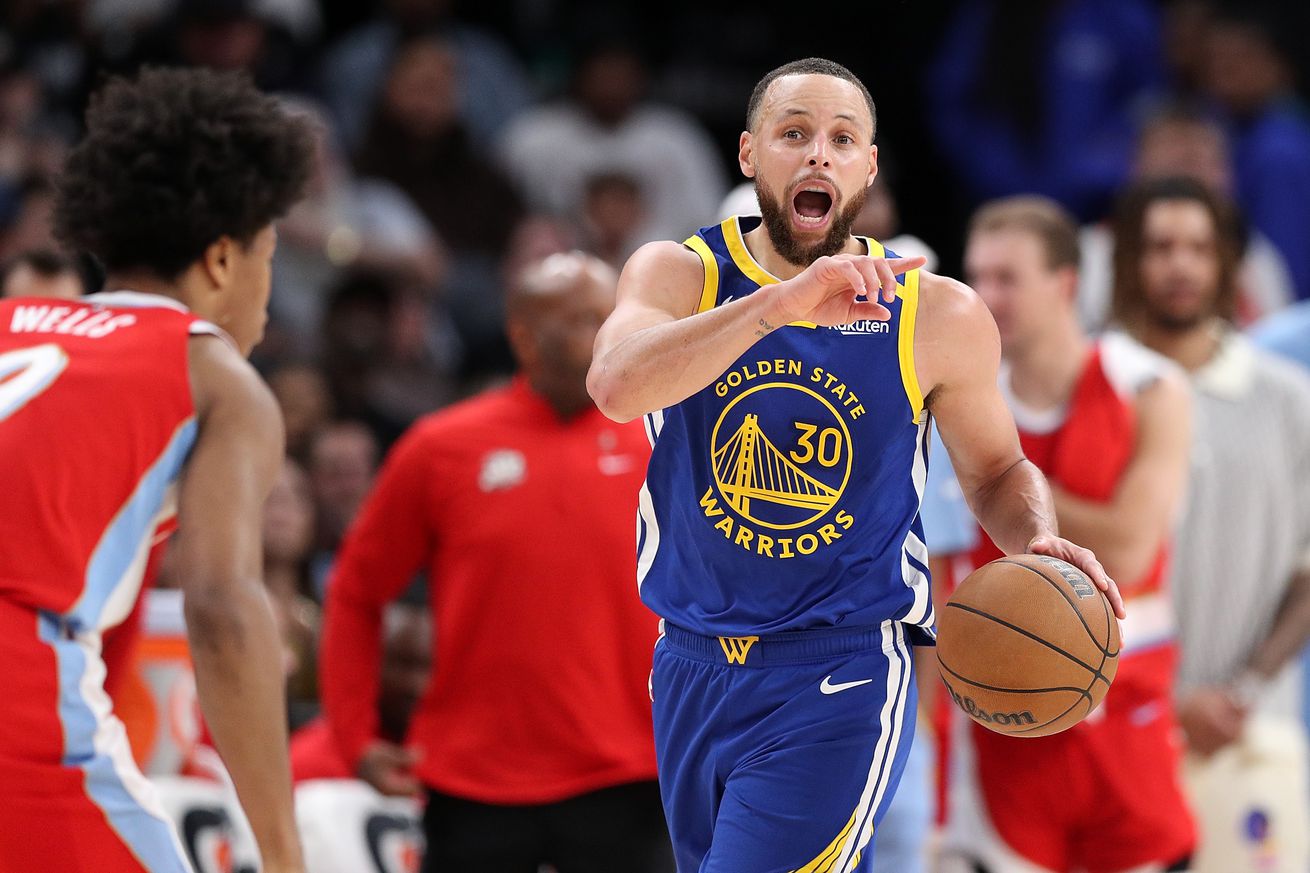
Curry dropped 52 points to help the Warriors climb to fifth in the Western Conference.
Few players sow fear and confusion with as little time on the ball as possible quite like Steph Curry does, a statement that’s been a fact for a decade. Curry makes use of the court like no other superstar that has preceded him — and, safe to say, like no superstar that will come after him, at least for the foreseeable future. Zero in on Curry in the midst of his shooting form and he exudes calm and poise, despite a platoon of defenders making panicked closeouts paired with all sorts of funky methods to shove him off-kilter (“shove” in this instance being used in the figurative and literal manner). If not for Jimmy Butler and Draymond Green (more on them later), it wouldn’t be farfetched to say that Curry damn near did everything for the Golden State Warriors tonight.
Whether that was flying for the defensive rebound after boxing out Jaylen Wells, maintaining his dribble, and making use of Green’s drag screen to shake Wells off of him and attack Zach Edey’s drop coverage…
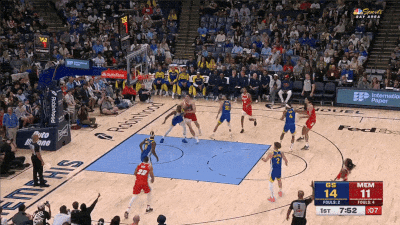
… or scoring, assisting, and garnering steals in passing lanes, Curry put up a gargantuan stat line in the Warriors’ crucial 134-125 win over the Memphis Grizzlies: 52 points, 10 rebounds, and 8 assists on 16-of-31 shooting from the field — 12-of-20 on threes — and a 75.3% True Shooting mark, to go along with 6 “stocks” (steals plus blocks).
Curry is a weapon in transition because of the threat of his unlimited-range pull-up threes. Defenses throw out all sorts of coverages in desperation in order to get the ball out of his hands — in other words, no matter who Curry’s surrounded with, whether it’s Kevin Durant or Jacob Evans III, the name of the game is quite simple: “Anyone but Steph Curry.”
Which is why Curry on the ball — while valuable and potent — has often taken a backseat to Curry off the ball. He starts plenty of possessions without the rock in his hands, but has also blended in possessions where he touches the ball to initiate, sees defenses sell out on him, and passes out of a potentially sticky situation.
Only for him to start his movement after making a pass — during which, as the great Doris Burke often says, the “real game” begins:
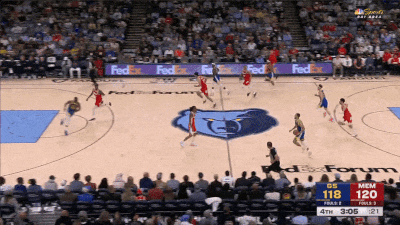
Perhaps the most amazing thing about Curry as he continues plying his trade at age 37 is how he maintains his deadliness off the ball — arguably even more deadly now than it was years ago, when there was an abundance of spryness and youth in Curry’s legs that helped him become an equally deadly on-ball operator, whether as a pick-and-roll ball handler or in isolation. Around 17.5% of the Warriors’ offensive possessions have ended in a Curry shot while darting around a screen away from the ball — during which they’ve scored 1.202 points per possession, an excellent mark per Synergy tracking.
That has been a more efficient play type for Curry in comparison to him as a ball handler in pick-and-roll situations, during which the Warriors have scored 1.060 points per possession (including possessions in which Curry passes to either the roll-man or a third teammate) — still an excellent mark relative to the rest of the league. Isolations, on the other hand, have been low in volume (154 possessions) and have been lower in efficiency relative to the aforementioned play types (0.902 PPP) although it’s by no means inefficient.
When comparing Curry’s combined isolation/pick-and-roll volume with his efficiency as a shot creator, it’s hard to pick Curry out from the list — if he’s even on the list to begin with, given that his on-ball creation volume has seemingly dipped relative to other main creators in the league:
This shows the number of self-created scoring attempts and the efficiency. This is the toughest skill to be good at in the league.
Most of the fraudulent #1 options are below the gray line, which is league average Creation TS% (52.9). #1’s need to scale up these playtypes. pic.twitter.com/DWQaUDgBZw
— databallr (@databallr) April 1, 2025
In Curry’s limited reps as an on-ball creator this season, his efficiency (measured in True Shooting percentage, or TS%) has seen a significant dip, all while maintaining his stratospheric efficiency on off-ball play types (i.e., spot-ups, handoffs, off screens, cuts, transition, etc.).
Steph’s creation TS% fell off. obv still has crazy efficiency elsewhere. Could be an unlucky year pic.twitter.com/f5F2m0zrLG
— databallr (@databallr) April 1, 2025
As the informative Twitter account above put it (a worthwhile follow), it may just be an “unlucky” year for Curry. But we must also take into account his age, the increase in frequency of ailments and injuries, and the undeniable-yet-sullen fact that he may be entering the twilight of his career. To compound those realities, Curry is still being guarded with the same kind of force, urgency, and aggression — by defenders that are getting much younger than him, much lengthier, and increasing in levels of athleticism and audacity.
As such, having the likes of Butler and Green alongside him to relieve the burden placed upon his shoulders on a nightly basis is becoming quite the luxury — while also being a paramount need. Butler, who finished the game with 27 points on a perfect 12-of-12 clip on free throws and 82.9% TS, has been especially valuable as an on-ball screener for Curry.
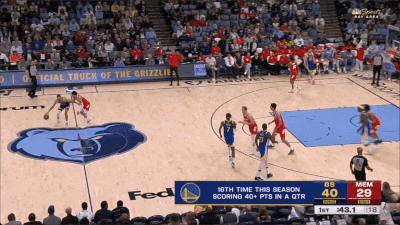
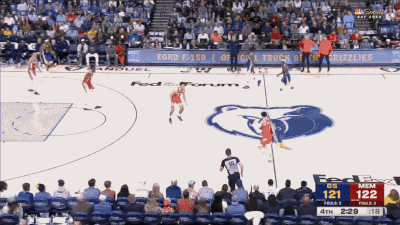
Meanwhile, Green’s decade-long chemistry with Curry has created an all-time mind meld between an all-time offensive threat and a player with the passing skills to boost it. As always, Green is one half of the recipe to counter the countless top-locking Curry sees on a near-nightly basis, especially against the Grizzlies, who employed Wells and Scottie Pippen Jr. as Curry’s designated “huggers.”
“I thought about their style (of) trying to junk up the game on defense, top-locks, and trying to send me into the paint, traffic and all of that,” Curry told reporters after the game. “We had a counter to that to start the game.
Curry is perhaps the league’s greatest top-lock counterpuncher, a product of having to deal with such a coverage for virtually his entire career as a superstar of the highest billing. But Green is the unsung hero behind Curry’s top-lock-beating exploits, not only because he forces his man (often the opposing defensive anchor whenever Green is the small-ball five) to have to decide whether to sag off or actively defend the ball — his passing acumen makes him perhaps the only one who can thread the ball through the tightest of windows.
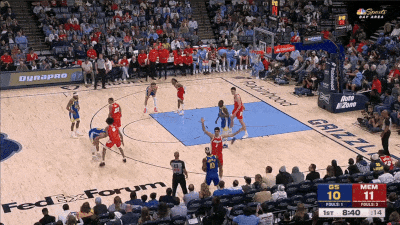
Curry’s counters to top-locking ranged from improvised situations like the one above, to drawn-up set pieces out of a timeout that had Curry be a seemingly uninvolved party in the Warriors’ patented split action — quite an unusual setup. However, it was with purpose: with Curry being top-locked voraciously by Pippen on the weak-side corner, the split cuts are but window dressing for Curry to sneak along the baseline and receive the pass from Green, who has Edey preoccupied with having to defend him in the post instead of protecting the rim:

Informed by the data and the film above, Curry has seen his lowest number of average seconds per touch in five seasons: 4.11. Opponents have been more successful at not letting Curry touch the ball and dictate things at the point of attack. That has compounded the importance of his off-ball shot creation, at the expense of his on-ball creation, which has suffered a dip in efficiency. Nevertheless, if the Warriors are to see success in the playoffs, that trend cannot continue. Fortunately for them, Curry and the Warriors are more equipped to punish teams who choose to drink the poison of being in constant rotation.